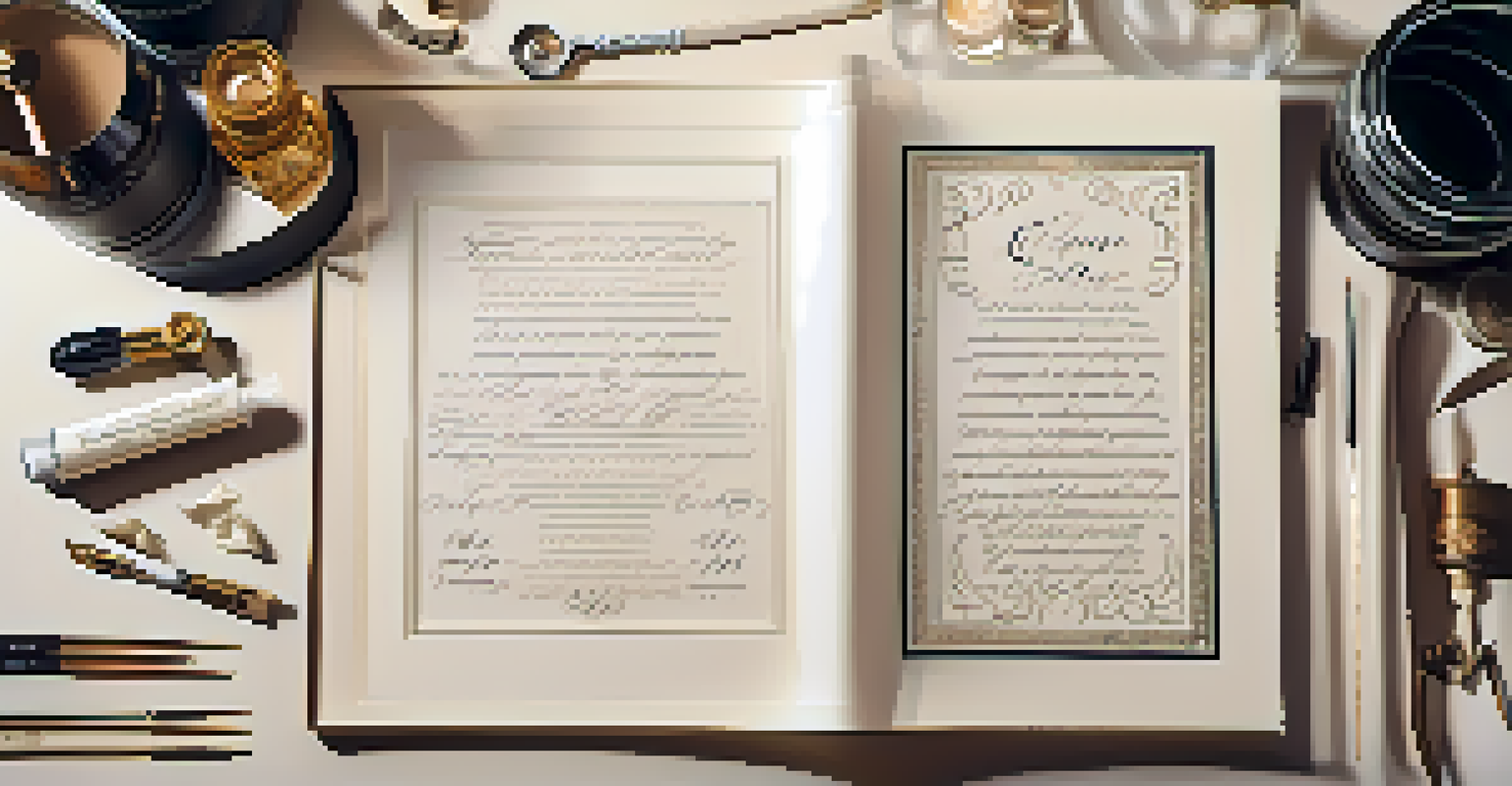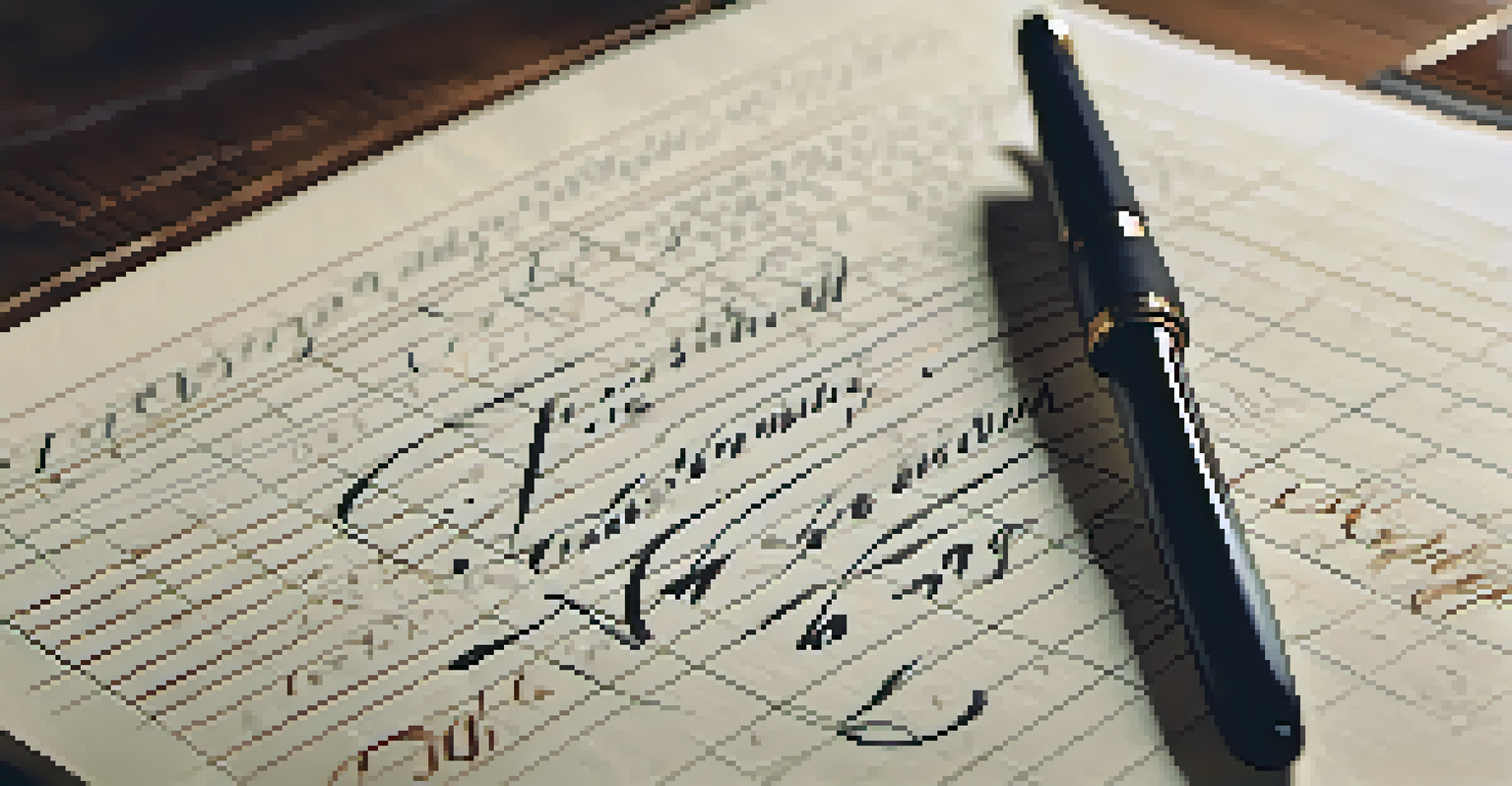Exploring Copperplate Calligraphy: Techniques and Tools

What is Copperplate Calligraphy and Its History
Copperplate calligraphy is a beautiful form of script that originated in the 16th century, known for its elegant curves and flourishes. It’s often seen in formal invitations and decorative writing. The name comes from the engraving techniques used to print letters on copper plates, which were popular during the Renaissance period.
Calligraphy is a form of art that transforms ordinary writing into something extraordinary.
This style is characterized by its use of a pointed nib, which creates fine hairline strokes as well as thicker downstrokes. The contrast between these strokes adds to its charm and visual appeal. Understanding the historical context helps appreciate why Copperplate remains a favorite among calligraphy enthusiasts.
As you delve into Copperplate, you'll find that its graceful nature encourages creativity. Whether you're preparing for a wedding, creating personalized stationery, or simply enjoying a new hobby, mastering this craft can be incredibly rewarding.
Essential Tools for Copperplate Calligraphy
To start your Copperplate journey, you'll need a few essential tools. A pointed nib, a nib holder, and quality ink are your primary requirements. The pointed nib, often made of metal, allows for the variation in stroke thickness that defines this style.

You'll also need good paper that can handle ink without bleeding, such as smooth, bleed-proof paper. Additionally, a straight edge and a lightbox can help with practice and alignment. Remember, having the right tools can greatly enhance your learning experience.
Understanding Copperplate Calligraphy
Copperplate calligraphy is an elegant script known for its graceful curves and historical significance, often used in formal writing.
Investing in quality tools not only improves your results but also makes the practice more enjoyable. Each tool serves a purpose, and familiarizing yourself with them will help you gain confidence as you practice.
Basic Techniques to Get Started
When starting with Copperplate, focus on mastering the basic strokes. These include upstrokes, downstrokes, and curves, which form the foundation for all letters. Practicing these fundamental strokes helps develop muscle memory, making letter formation easier over time.
Practice is the mother of all skills.
Begin by practicing on a grid or lined paper to maintain consistent sizing and spacing. This structured approach will aid in achieving uniformity in your writing. Remember, patience is key; each stroke takes time to perfect.
As you gain confidence, start connecting these strokes to form letters. The transition from individual strokes to complete letters can be challenging, but with practice, you'll find it becomes second nature. Celebrate small victories along the way!
The Importance of Consistency in Practice
Consistency is crucial in Copperplate calligraphy, as it helps develop a personal style while maintaining legibility. Regular practice allows you to refine your technique and understand the nuances of each letter. Aim for short, daily practice sessions rather than long, infrequent ones.
Track your progress by keeping a calligraphy journal where you can date your entries and note improvements. This not only serves as a motivational tool but also highlights how far you’ve come. Remember, every artist has their unique journey, so embrace yours!
Essential Tools for Beginners
Key tools like a pointed nib, quality ink, and smooth paper are crucial for starting your Copperplate calligraphy journey.
As you practice, don’t be afraid to make mistakes. Each error is a learning opportunity that can lead to breakthroughs in your skill. The more you write, the more comfortable you’ll become, and before you know it, consistency will become second nature.
Choosing the Right Ink for Copperplate
Selecting the right ink is pivotal for achieving beautiful Copperplate lettering. Traditional calligraphy inks are usually thicker, providing a rich color and smooth flow when applied with a nib. You might experiment with different types of ink, such as fountain pen ink or even sumi ink, to find what suits your style.
Consider using a dipping ink for a more authentic experience, as it allows for better control over the ink flow. Make sure to test your ink on practice paper before committing to a project, as different inks behave differently on various surfaces.
The right ink can enhance your work's overall appearance, so don’t rush this decision. Take your time experimenting until you find the perfect match for your writing style.
Creating Beautiful Lettering: Tips and Tricks
Once you're familiar with the basics, it’s time to explore ways to create stunning lettering. Experiment with different styles and variations of letters to make your writing unique. Adding personal touches, like flourishes or embellishments, can elevate your work to new heights.
Utilize resources such as online tutorials, calligraphy books, and community forums to gather inspiration and techniques from other artists. Observing different styles can ignite your creativity and help you develop your own flair.
Join the Calligraphy Community
Engaging with the calligraphy community provides support, inspiration, and opportunities for growth through shared experiences.
Remember, the beauty of Copperplate lies in its elegance, so don’t rush the process. Enjoy the journey of discovering your style and creating art that reflects your personality.
Joining the Calligraphy Community for Support
Becoming part of the calligraphy community can provide invaluable support and encouragement. Look for local workshops, online classes, or social media groups where you can connect with fellow learners and experienced artists. Sharing your progress and challenges can foster a sense of belonging.
Engaging with others also opens up opportunities for constructive feedback and tips from seasoned calligraphers. Don’t hesitate to ask questions; the community is often eager to help and share their insights. Remember, everyone was a beginner at some point!

Participating in calligraphy challenges or competitions can also motivate you to improve and push your boundaries. Embrace the camaraderie and inspiration that comes from being part of this vibrant artistic community.